Home / Destinations / Japan / The Perfect 4 Day Osaka Itinerary

The third largest city in Japan, Osaka is a full-throttle, fun-loving party town lit by an explosion of neon. Osaka’s skyline is littered with landmarks, including the famous Glico Man, Osaka Castle and the tallest skyscraper in Japan. Our four day Osaka itinerary uncovers the very best of this intoxicating and dazzling metropolis.
Affectionately known as ‘Japan’s kitchen’, Osaka is a utopia for foodies, fuelled by a seemingly limitless supply of some of the best food in the country.
Often overshadowed by Kyoto – its cultured and classier near neighbour – visitors to Japan ignore Osaka at their peril.
We’ve spread out our 4 day Osaka itinerary so that each day covers specific areas of the city.
Osaka is a large place and if you only have a few days here it’s best to focus on certain parts of the city on each day to make the most of the time that you have.
Here’s the breakdown of our Osaka four day itinerary:
Day 1 – In and around Namba, including Shinsaibashi, Amerikamura and Dotonbori
Day 2 – Osaka Castle and Umeda
Day 3 – Sumiyoshi Taisha, Korea Town, Tennoji and Shinsekai
Day 4 – Osaka Aquarium and Universal Studios, or a day trip from Osaka
When looking for somewhere to stay in Osaka it pays to find accommodation close to one of the main stations such as Umeda, Namba or Tennoji. This will make your travelling times shorter and make getting around the city much easier.
You can search for accommodation in Osaka here. If you need a few suggestions here are a few places that we recommend:
Affordable
The 2-star Hotel Kojan features good-sized rooms with all of the amenities you could ever need. Located right in the heart of Osaka, Hotel Kojan is close to all of the action, just a few minutes walk from Dotonbori and right next to Shinsaibashi station, making it perfect for exploring the rest of the city.
Next Level
At little further north is Hotel Cordia Osaka Hommachi, a stylish and modern 3-star hotel within easy reach of Osaka and Umeda stations as well as Hommachi metro station. The hotel’s comfy well-sized rooms feature soft beds as well as Apple TV.
Top of the Range
If you want to stay in Osaka in style then there’s no better hotel than the W Osaka. This ultra-chic 5-star hotel is designed to impress, with stunning rooms, 4 on-site hotels, an onsite wellness centre and a swimming pool. Located close to both Shinasaibashi and Hommachi metro stations
The first day in our 4 day Osaka itinerary is spent in and around Namba and Shinsaibashi. Both areas are home to some of Osaka’s most iconic sights and well known neighbourhoods.
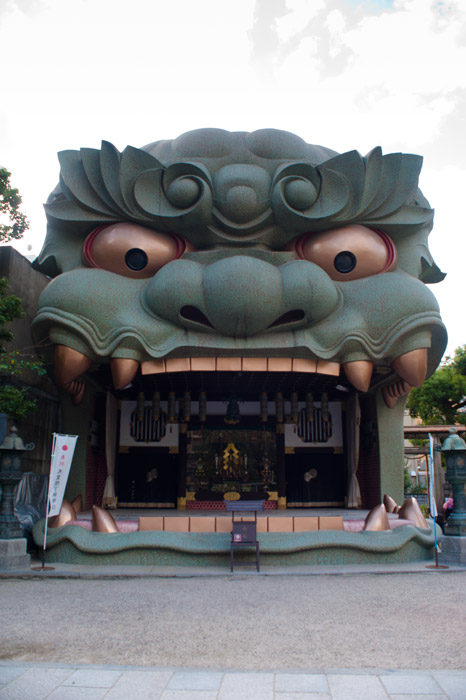

The giants lion’s head shrine and prayer plaques at Osaka’s Namba Yasaka
Tiny Namba Yasaka’s most famous feature is the huge shrine shaped as a lion’s head. Standing at twelve metres in height, the head of the lion is said to scare away evil demons, bringing good luck and prosperity.
From Namba Yasaka, make your way to Den-Den Town. Den-Den Town is Osaka’s equivalent to Akihabara in Tokyo.
If you’re looking for anything to do with anime or manga in Osaka, Den-Den Town is the place to come. Here you’ll find all kinds of stores that specialise in all manner of anime collectibles.
Den-Den Town is centred around two main parallel streets, Ota Road and Nipponbashisuji. Alongside manga Den-Den Town is also the place to hunt for second hand treasures, including retro gaming consoles, antiques, books and CDs.
The best bargains can be found by wandering around the huddle of narrow lanes behind the huge Joshin store on Nipponbashi.
From Den-Den Town walk the short distance to Kuromon Market on the opposite side of the road for a spot of lunch.
One of the best things to do in Osaka is eat and in a city utterly fixated by food, Kuromon Market is one of the best places in the city to get your fill.


Fresh seafood and flame grilled yakinuki in Kuromon Market
Kuromon Market is also a great place to try a variety of Osaka’s most famous dishes at a pretty reasonable price. Everything from yakiniku, takoyaki, and succulent sushi and sashimi are available from the market’s countless street food stalls.
There’s also a huge array of restaurants and bars where you can sit in and gorge yourself on the freshest seafood and mouth-watering Kobe beef.
Once fully fed, continue north past Nipponbashi station towards Dotonbori. Dotonbori is best enjoyed at night, when the whole area is abuzz with neon, but for now head to Hozenji temple.
Buried deep within a warren of tiny alleyways, Hozenji is home to one of Osaka’s most famous shrines.
During the Second World War almost all of this area was reduced to rubble by allied bombing campaigns, including the original Hozenji temple. Only one statue of a Buddhist spirit called Fudo Myo-o survived.
Since the end of the war the statue has been seen as a good luck figure. Pouring water on Fudo Myo-o is said to ensure that all of your wishes will come true. As a result the small statue is now covered in a thick layer of green moss.

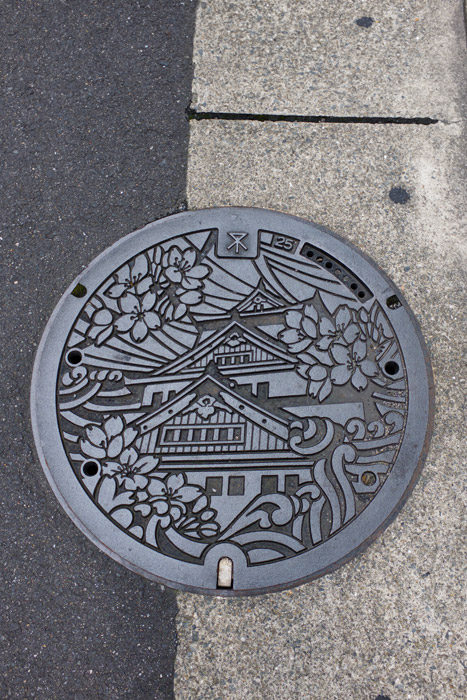
The moss-covered statue of Fudo Myo-o at Hozenji Temple and a manhole cover embossed with Osaka Castle
Directly north of Hozenji temple are the flashy bustling streets of Dotonbori, which we will come back to later in the evening. For now cross over the Dotombori-bashi bridge to reach another of Osaka’s most well-known areas, Amerikamura.
If Den-Den Town is the Osakan Akihabara, then Amerikamura is Osaka’s version of Harajuku. The area became known as Amerikamura in the early 1970s when a number of shops opened specialising in imported vintage American clothing. Ever since Amerikamura has been hive of youth culture and fashion.
Super trendy vintage clothing stores and edgy street art are still at the heart of Amerikamura. The area is centered around Mitsu Park, also known as Sankaku-koen (literally Triangle Park), a popular hang-out place right in the middle of Amerikamura.
All around it are a swarm of fashion stores selling everything from imported second hand clothes, trainers, baseball caps and jewellery, as well as chic cafes, live music venues and bustling bars.
Just a stone’s throw from Amerikamura is Osaka’s most famous area, Dotonbori. Like Japan in overdrive, Dotonbori is a glorious mix of old buzzing neon, food-filled streets and rampant consumerism.
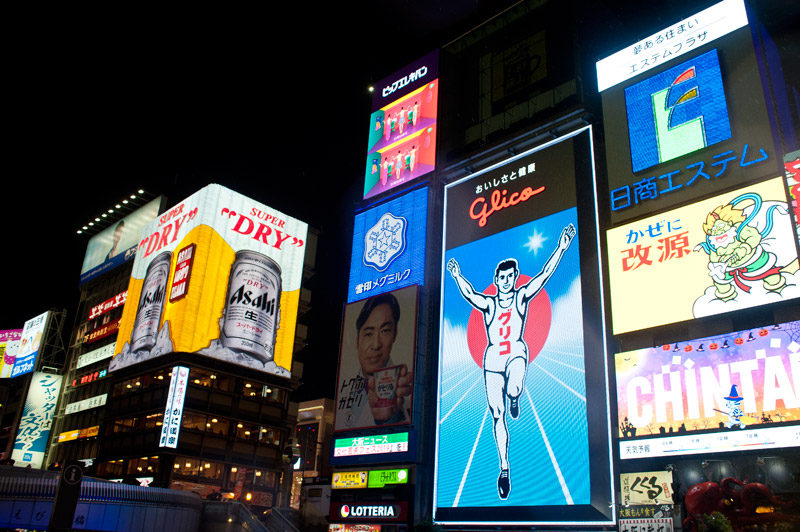
Walk along Dotonbori canal towards one of Osaka’s most instantly recognisable landmarks, the Glico Man.
The Glico Man has been in this same spot since 1935, advertising candy made by the Osakan brand. Previous versions of the Glico Man were all made of neon, though the latest incarnation is lit by more environmentally friendly LED lights.
Continue along the canal and pick up some of the best takoyaki in Osaka from Acchichi Honpo. Then cross over to the southern side of the canal to see Dotonbori’s most spectacular street.
Here, everything from giant dragons, plates of gyoza, bright red octopus and moving mechanical crabs hang over every restaurant, filling almost every square inch of the skyline.
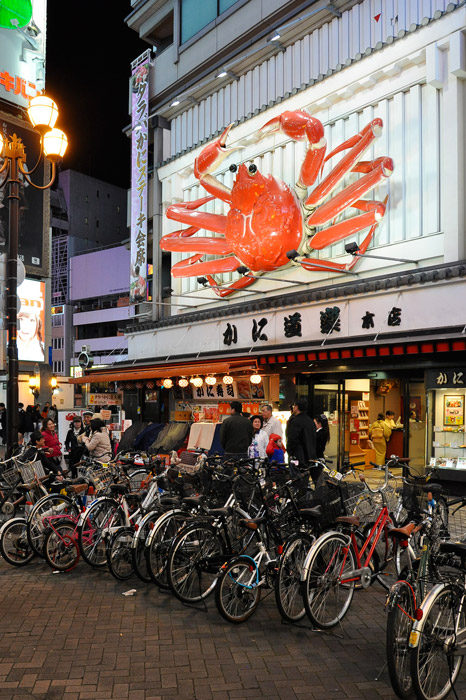
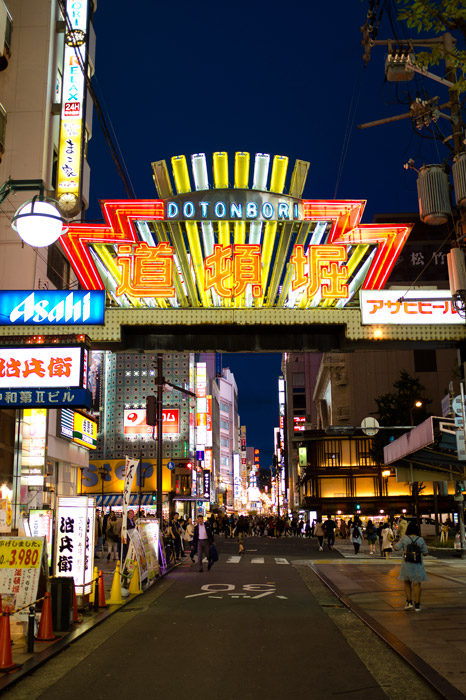
Kani Doraku’s famous mechanical crab and Dotonbori’s neon lights
It’s impossible to eat badly in Osaka, but if you want to get away from the tourist trail and find somewhere local to eat then head over the Ebisu Bridge and back across the canal into Shinsaibashi.
From the covered Shinsaibashi-Suji shopping street take a right turn to find hundreds of bustling local restaurants.
As you’d expect, all of Osaka’s staples foods can be found here. For delicious takoyaki try Takotako King, or for sumptuous barbecued meats head to Yakiniku Rokko. If you fancy okonomiyaki then don’t miss Sourumeito Shinsaibashi.
Start the second of your four day Osaka itinerary with a visit to one of the city’s most famous landmarks, Osaka Castle. Then spend the second half of the day on the vibrant streets of Umeda.
Originally built in 1583, Osaka Castle has been destroyed and reconstructed numerous times throughout its history. The most recent restoration of the castle came after World War Two, when it was repeatedly bombed during allied attacks.
Osaka Castle has since been fully restored and was opened up to the public in 1953. Today Osaka Castle is an iconic symbol of the city.

Osaka Castle is surrounded by huge grounds which are a wonderful place to stroll, especially in spring when hundreds of cherry blossom trees are in full bloom.
Inside Osaka Castle is a museum that documents the history of the castle, from its early origins under the command of the samurai warrior Toyotomi Hideyoshi right up until the latest reconstructions.
Also on display are various historical artefacts, including body armour and ancient swords that once belonged to samurai fighters. The main highlight of Osaka Castle is the incredible view overlooking the city from the observation deck of the main tower.
From Osaka Castle, take the Tanimachi line to Minami-Morimachi station to get to Tenjinbashisuji shopping arcade. Covered shopping arcades, known as shōtengai in Japanese, are a common sight in Japan.
There are several shōtengai in Osaka, and at over two and a half kilometres in length, Tenjinbashisuji is the longest in Japan. Take exit 3 at Minami-Morimachi station to join Tenjinbashisuji at around the halfway point.

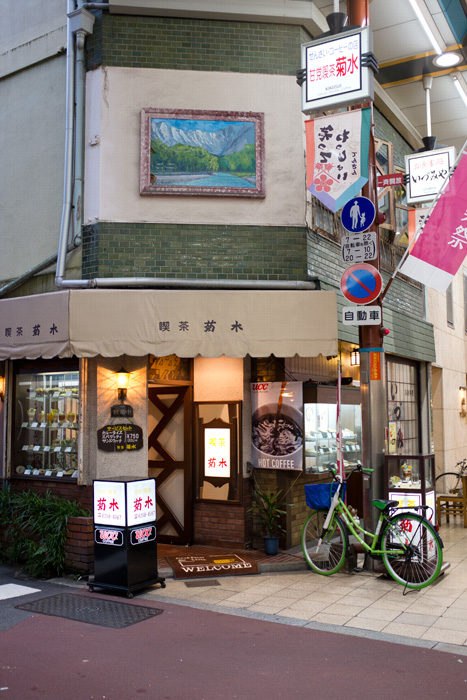
Teninbashisuji shopping arcade
Tenjinbashisuji’s origins go as far back as the 17th century, which also makes it one of the oldest in Japan.
Today there are over 800 shops inside Tenjinbashisuji, and many of those have been here for decades. Unlike Osaka’s other shōtengai, there are no major shopping chains to be found in Tenjinbashisuji.
Instead Tenjinbashisuji is filled with local stores that sell everything from groceries, kimonos, books, flowers and homewares. This being Osaka, there are also countless cafes and restaurants, making Tenjinbashisuji a perfect place for a spot of lunch.
At the far northern end of the covered section of Tenjinbashisuji is the Osaka Museum of Housing and Living.
On one floor of the museum is a faithful recreation of a section of Osaka as it would have looked during Japan’s Edo Period in the 1830s.


The Osaka Museum of Housing and Living
The re-imagined streets are lined with replicas of traditional houses as well as a bath house, shops selling woodblock prints and noodles and restaurants. The indoor lighting even changes to reflect day and night, so you can see experience old Osaka at all hours of the day.
On the floor below there is another exhibition that documents how Osaka has changed since the Edo period. Large models show how sections of Osaka developed in the early 20th century and following the Second World War.
There’s also a large scale model of the original Tsutenkaku Tower and Luna Amusement Park that once stood around it.
To see just how much the city has changed get a bird’s eye view of modern day Osaka from the viewing platform on top of the Umeda Sky Building.
The 39th and 40th floors connect the east and west towers and provide a sensational view over Osaka.
It could be argued that the views from Abenos Harukas 300 (see day 3) are even more impressive as it’s closer to more of Osaka’s main sights.
Yet the Umeda Sky Building does have an open rooftop observation deck, allowing a totally unrestricted view of Osaka’s sprawling skyline.
Afterwards, walk through Umeda to Tsuyu Tenjinsha, also known as Ohatsu Tenjin Shrine. Today the entrance to this small shrine is hidden between a mass of bars and restaurants, but Ohatsu Tenjin dates back well over 1000 years.
The current shrine is a restoration following the severe bombing of the Second World War, but Tsuyu Tenjinsha will always be associated with the tragic tale of Ohatsu, a prostitute, and her lover Tokubei. The two lovers committed suicide in the grounds of the shrine in 1703.
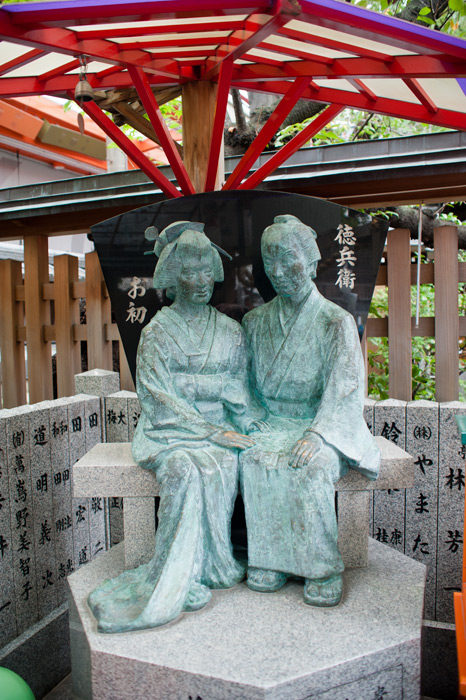

The statue of Ohatsu and Tokubei and a row of torii gates at Ohatsu Tenjin shrine
The story of their doomed love became the basis of a bunraku play that echoes the story of Romeo and Juliet called The Love Suicides of Shonezaki.
In the play Ohatsu and Tokubei’s attempts to be together are thwarted by family feuds and betrayal. The shrine has been known as Ohatsu Tenjin ever since in honour of the heroine of the tale.
Today the Ohatsu Shrine is popular with young couples and those looking for love. A small statue of Ohatsu and Tokubei stands in the grounds alongside a row of vermillion torii gates.
Wooden plaques bearing the images of the couple hang nearby on which visitors write their hopes of finding love.
Immediately outside the northern entrance to Ohatsu Tenjin is Sonezaki Ohatsutenjin-dori. This covered street is filled with many excellent cafes, restaurants and bars.
Popular with the office workers of Umeda, the area becomes crowded and lively at the end of the working day.

Reasonably priced and with a great atmosphere this is a great place to grab some food and watch Osaka unwind.
As you’d expect of Osaka there’s a world of choice to be found here. For some of the best okonomiyaki in town wait in line for a free table at Yukari Sonezaki.
On the third of your four days in Osaka, spend the morning at Sumiyoshi Taisha, one of the city’s most beautiful shrines, before wandering the alleys and streets of Korea Town.
Then in the afternoon head to Tennoji to see more of Osaka’s most famous landmarks.
Set amongst beautifully tranquil grounds in the south of Osaka, Sumiyoshi Taisha was originally built in the 3rd century.
One of the oldest and most important shrines in Japan, over two million people come to Sumiyoshi Taisha to worship during the traditional New Year celebrations.

The flat roofs of the main shrines at Sumiyoshi Taisha are of a distinct architectural design, known as Sumiyoshi-zukuri, which predate the style now commonly associated with Japanese temples and shrines.
In front of the entrance to the shrine is the stunning arched Sorihashi Bridge. The bridge’s bright, bold vermillion railings cast a spectacular reflection in the pond below.
Inside the shrine complex there are four main halls. Sumiyoshi Taisha is dedicated to the safe passage of sailors, and the layout of the halls is said to resemble ships heading out to sea.
Three of the halls sit side by side, with the fourth directly behind, nestled amongst 1,000 year old trees.
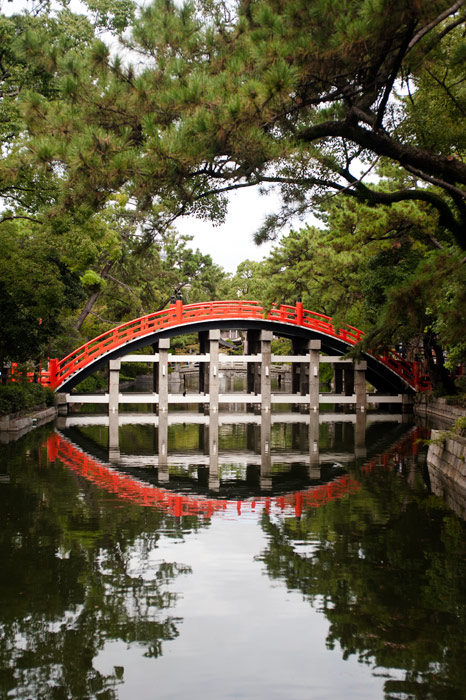
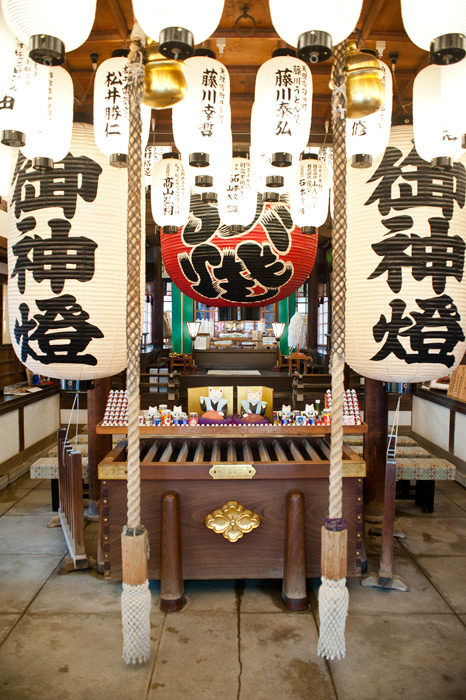
The arched bridge and the Nankun-sha shrine at Sumiyoshi Taisha
At the rear of the shrine is Nankun-sha, a shrine filled with glowing lanterns and cat figures, called Maneki Neko, which are believed to bring prosperity and business success.
Nearby in a separate shrine are the Omokaru stones. More like small boulders, the tradition is to pick up a stone and make a wish. If the stone is lighter the second time you pick it up then your wish will come true.
Next, take the tram from Sumiyoshitoriimae opposite the entrance to Sumiyoshi Taisha to Tennoji.
From there make your way to Tsuruhashi to explore Osaka’s fascinating Korea Town. Osaka has the largest Korean community in Japan by far, with many ethnic Koreans settling in the area around Tsuruhashi after the Second World War.
Immediately to the south of Tsuruhashi station is a sprawling warren of old covered lanes and narrow alleys. Like stepping back in time, here you’re more likely to find stalls selling kimchi and K-pop than sushi or kimonos.

The market is filled with foods used in traditional Korean meals as well as plenty of clothes shops, many of which specialise in hanbok, traditionally worn during Korean weddings.
There are also dozens of traditional Korean restaurants, shops selling Korean cosmetics as well as a number of karaoke rooms.
A few blocks to the south and east of the Tsurahashi’s covered market is an area called Ikuno Korea Town. Mostly centred around one long pedestrianised street, Ikuno Korea Town feels even more like Seoul or Busan.
Pass through the Korea Town arches and you’ll find countless stores selling Korean CDs and DVDs, tubs filled with a huge range of fresh kimchi and Korean street food.


Korean restaurants and kimchi on sale in Osaka’s Korea Town
Dotted along the street are statues of stone grandfathers, or dol hareubang, commonly associated with Jeju Island, where many of Osaka’s Korean community originally came from.
Cute and cosy cafes can be found in the side streets just off the main drag, whilst the smell of freshly grilled beef and pork wafts out onto the street from Korean barbecue restaurants. This is as close to being in South Korea without actually going there.
From Korea Town return to Tennoji station and make your way to Harukas 300, the viewing platform at the very top of the Abeno Harukas skyscraper.
Even if you’ve already scaled to the top of Umeda Sky Building, we’d recommend taking the views from Abeno Harukas 300.

Not only is Abeno Harukas more centrally located, meaning you get a better view of Osaka’s skyline, but it is also the tallest skyscraper in Japan.
The ‘300’ in the name refers to the height of the building, which is 300 metres tall. Needless to say the 360 degree views over Osaka at such a vantage point are phenomenal.
As well as breathtaking views, Abeno Harukas tower is also home to several floors of restaurants, a food court that covers two further floors, an art museum and the largest department store in Japan.
Next, head to Shittenoji Temple, which is around a ten minute walk north from Abenos Harukas.
Shittenoji is one of the oldest temples in Japan, and though the original temple has suffered from numerous fires, each time it been restored based upon its original 6th century design.
The large temple complex is entered through a huge entrance gate. At the heart of Shittenoji Temple is the inner precinct, for which there is a small entrance fee.
Inside the inner precinct stands a magnificent five-storied pagoda opposite a grand main hall that features magnificent wall paintings that tell the story of the life of Buddha.
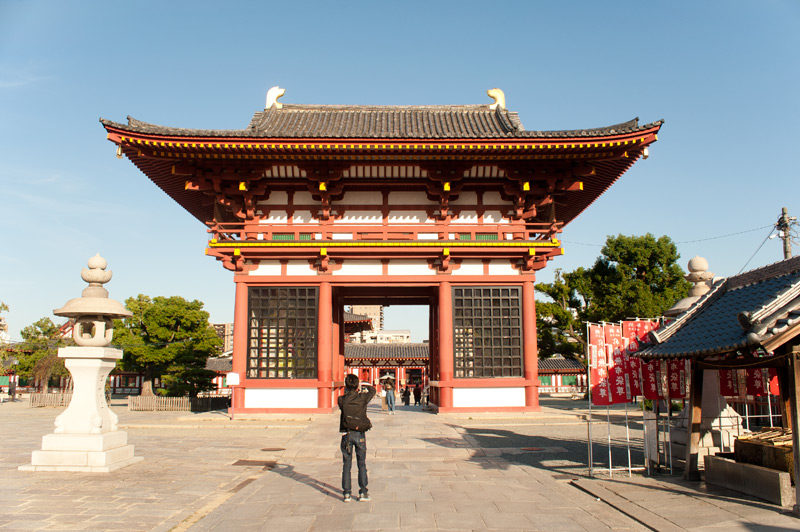

The entrance gate and pagoda at Shittenoji Temple
On the northern side of the temple’s grounds is Gokuraku-jodo Garden. A beautifully manicured Japanese garden, Gokuraku-jodo is a wonderful oasis in the middle of the city, especially during autumn or cherry blossom season.
From Shittenoji it’s only another ten minute walk to another of Osaka’s most famous landmarks, the Tsutenkaku Tower.
Another symbol of the city, the current Tsutenaku Tower is the second version, with the first having succumbed to fire in 1943. In 1956 a replacement tower was built at double the height of the original.
Modelled on the Eiffel Tower, Tsutenkaku is a wonderfully old-school attraction, steeped in the era in which it was built.
Inside the tower a narrow rickety lift crawls to the viewing platform on the fifth floor, where you’ll find Billiken. The tower’s mascot, rubbing the golden feet of Billiken is said to bring good luck.

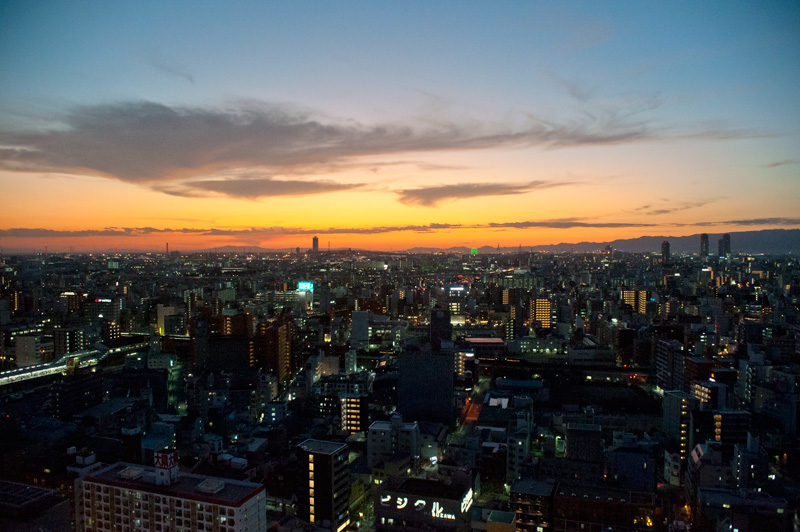
Tsutenkaku Tower and the view from the tower’s viewing platform
The views aren’t as high from the top of Tsutenkaku Tower as they are from Abenos Harukas or the Umeda Sky Building but they are no less impressive.
It’s worth paying the extra 500 yen to take in the view from the small open-air viewing platform above the fifth floor. If you arrive in the late afternoon you might be treated to a spectacular sunset.
Afterwards, take a wonder around the spell-binding streets of Shinsekai immediately to the south of Tsutenkaku Tower.
Shinsekai is famous for its spectacularly overblown shopfronts which are all fantastically lit up at night. Huge octopus and puffer fish hang over Shinsekai’s restaurants, many of which specialise in the Osakan speciality kushi-katsu.
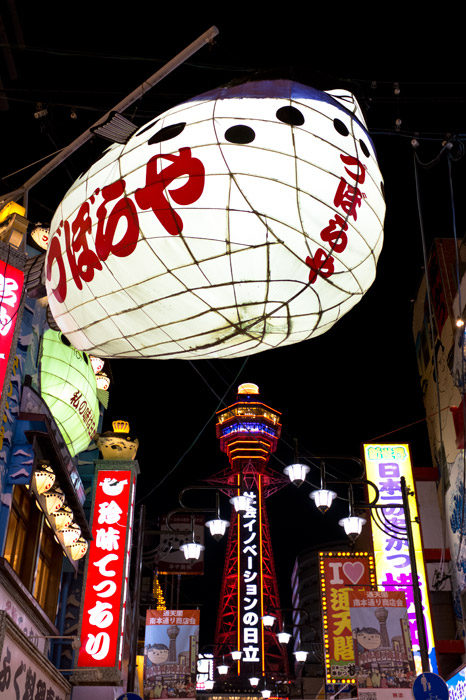

Shinsekai’s neon-lit streets and kushi-katsu, a speciality of the area
Morsels of battered meats and vegetables skewered and then deep fried, kushi-katsu is said to have been invented in Shinsekai, and there are dozens of restaurants and bars here where you can try it.
There’s no better way to end the day than with a nice cold beer and a platter of freshly fried kushi-katsu dunked in sauce.
Two of Osaka’s biggest tourist attractions are undoubtedly Universal Studios Japan and Osaka Aquarium. Both attractions are located to the west of the city centre in Osaka Bay and draw millions of visitors a year.
You can easily spend the whole day at Universal Studios Japan. Alternatively, you could start the day at Osaka Aquarium before making your way over to Universal Studios.
If aquariums and theme parks aren’t your cup of tea and you’d prefer to see more of Japan, consider taking a day trip from Osaka.
Osaka is incredibly well connected to a number of nearby cities, making a day trip out of town incredibly simple, even more so if you have a Japan Rail Pass.
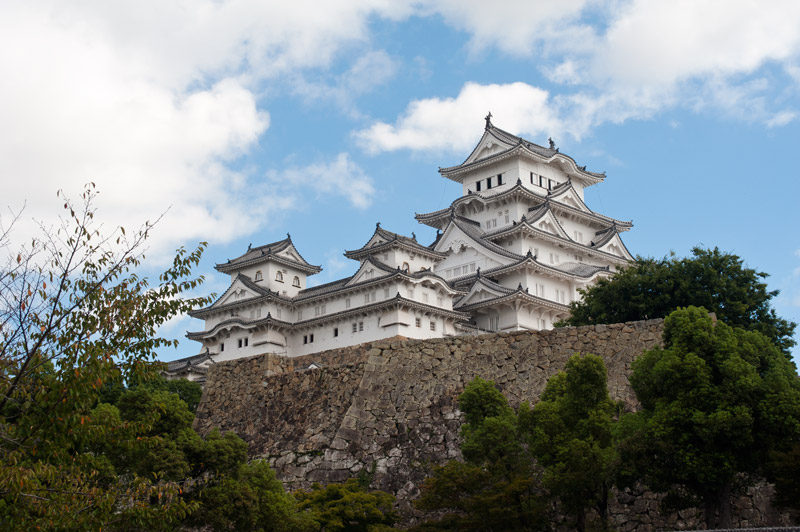
Only fifteen minutes from Osaka by Shinkansen, the beautiful city of Kyoto in the obvious choice for a day trip from Osaka.
If you’re on a budget, a regular JR train can still get you to Kyoto in around 45 minutes, giving you plenty of time to visit some of the hundreds of beautiful temples and shrines that can be found in Kyoto.
The historic port city of Kobe is another option, being less than quarter of an hour away by Shinkansen.
Alternatively, a day feeding the deer in Nara is just as easy. There are several direct trains an hour from Osaka JR station bound for Nara, with the journey taking around 50 minutes.
Another popular day trip is a visit to Himeji to visit Japan’s most spectacular castle. Just half an hour from Osaka, Himeji Castle is one of the best preserved castles in Japan, having never been damaged by fire, natural disaster or war.
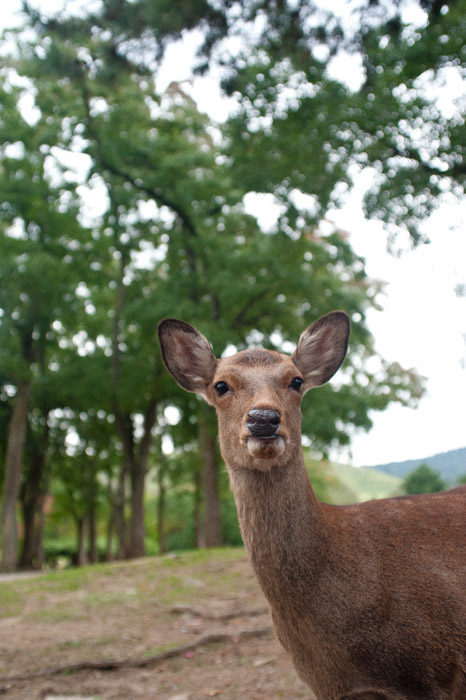
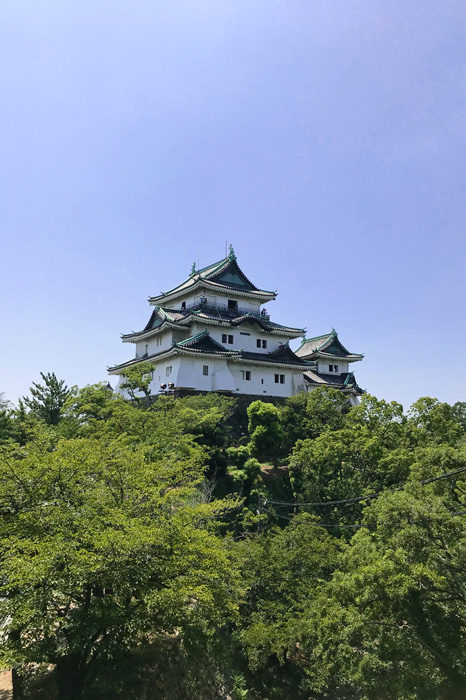
The cities of Nara and Wakayama also make excellent day trips from Osaka
Alternatively you could head south to visit the historic city of Wakayama, home to another spectacular castle and famous for its chunky ramen.
Or you could even visit Koyasan, the spiritual home of Shingon Buddhism and a contender of the most sacred town in Japan.
With so much on the city’s doorstep and all within easy reach, there are so many great places to visit that make wonderful day trips from Osaka.
Osaka is easily reached from many of Japan’s major cities. From Tokyo it’s just over two and half hours to Osaka by bullet train. Kyoto and Kobe are even closer, taking a frighteningly fast fifteen minutes to get to Osaka from either city by Shinkansen.
If you’re heading straight to Osaka from overseas then the nearest airport is Kansai International Airport, which is around a 40 minute train ride from Osaka.
There are a few different ways to reach Osaka from Kansai Airport by rail. The JR Haruka Express is the quickest option, getting to Tennoji station in half an hour and Shin-Osaka station within 50 minutes.
The JR Kansai Airport Rapid line is a cheaper option, but takes around 15 minutes longer to get to central Osaka. Also available is the private Nankai Rapi:t line which takes 45 minutes to get to Namba Station.
» If you are looking to fly into Osaka you can search for the best deals on flights into Kansai International Airport here.
Getting around Osaka is pretty straightforward thanks to the city’s extensive train and metro networks.
If you’re spending four days in Osaka then it’s worth getting an Icoca card, the prepaid card that can be used on all metro lines and buses.
Icoca cards can be bought from the ticket machines at any JR rail and metro station, costing a minimum of ¥2000, of which ¥500 is a deposit for the card and ¥1500 is credit.
If you need to add value to the card at any point you can do this at the same ticket machines which have instructions in English. Prepaid cards from other cities in Japan, such as Suica and Pasmo, can also be used in Osaka.
» You can also pre-order an Icoca IC card preloaded with ¥1,500 here.
If you’ve liked this post please share it on the socials:
Follow our travels on Instagram here, and keep up to date with our latest posts on Facebook here.

Please note that this post contains some affiliate links. If you click these links and go on to make a purchase we will earn a small commission at no extra cost to you.
© WhereYoureBetween.com – 2023
Cookies help us deliver our services.
By continuing to browse this site, you agree to our use of cookies.
There's a World Out There. Let's Go!
Sign up to our email newsletter for a monthly(ish) dose of wanderlust